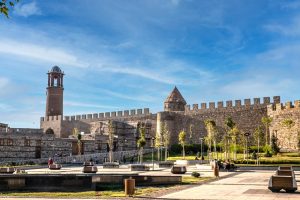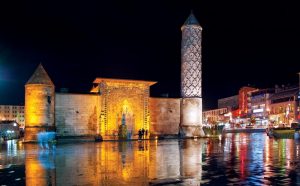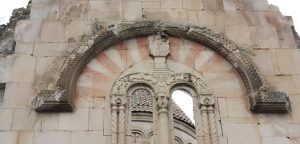Hightlight
-
 Air conditioner
Air conditioner
-
 Credit cards
Credit cards
-
 Reservations
Reservations
-
 Tour Guide
Tour Guide
ERZURUM CASTLE:
The history of Erzurum Castle dates back to about 2,500 years ago, to the Urartians, who dominated the region. The first version of the inner castle, which still exists today, was built by the Byzantine Emperor Theodosius in 415.
Erzurum Castle consists of the inner castle, where the guard soldiers are located, and the outer castle, which includes the streets, streets and neighborhoods where the people reside. There is a brick bath and rooms in the courtyard of the inner castle. During the Ottoman Empire, the Citadel Masjid was built next to the northern wall of the citadel. Kırklar Tomb, Ebu İshak-ı Kâzerûnî Tomb and Ali Ağa Fountain were added to these structures.
Today, the walls of the outer castle have been largely destroyed and only the names of the gates opening to four directions are known. These are the Tabriz Gate, the Erzincan Gate, the Georgian Gate, and the later opened Istanbul Gate and the New Gate.
Address: Camiikebir Mh., 25200 Yakutiye/Erzurum
YAKUTIYE SCHOOL (MEDRESE):
Yakutiye Madrasa reflects the traditional architectural style of the Seljuk Period and is located in the group of madrasas with four iwans and closed courtyards. When the Mongols ruled this region, Yakutiye Madrasa served as a Mongol theological seminary and dated back to 1310. The Mongols used this monument to train their priests and rabbis. You will see variations of geometric plant and animal motifs within the décor of the structure.
The Three Tombs (Üç Kümbetler):
Historical site comprising a cluster of medieval-era monumental stone tombs with conical roofs.
The cluster of three tomb towers known as Üç Kümbetler (“Three Tombs”) is located just south of the city center of modern Erzurum. In the medieval period, the tombs would have lay outside the city walls not far from Tabriz Kapısı (Tabriz Gate). The largest tomb, locally referred to as the Tomb of Emir Saltuk, is tentatively dated to the late twelfth century/sixth century AH. Based on stylistic comparisons, scholars date the other two tombs that are unmarked and unnamed to the fourteenth century/eighth century AH.
All three tomb towers are based on the same type of plan: a cylindrical or polygonal shaft with a conical roofs. The Tomb of Emir Saltuk is distinguished by its octagonal plan with sides rising to a short gable under its roof, which is squatter than the others. The other two tombs have cylindrical bodies decorated with a series of blind arches and conical roofs.
Oskvank – Oshki Monastery & Church:
The Oshki Oskvank Monastery, located in the village of Çamlıyamaç in present-day Erzurum province, was built in the historic province of Tao during the latter half of the 10th century. The monastery’s main church, dedicated to St. John the Baptist, was constructed between 963 and 973.
In the Middle Ages, Oshki Monastery was an important center for Georgian literature and culture, and it is considered to be “one of the largest and most architecturally advanced structures ever created in the Eastern Christian world.” The construction of the monastery at Oshki was sponsored by Grand Duke/King Bagrat II of Tao and David III of Tao.
























